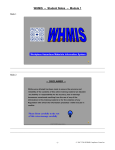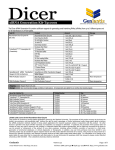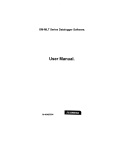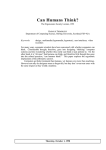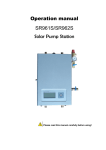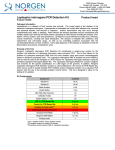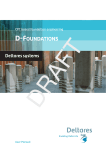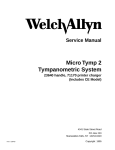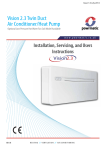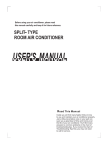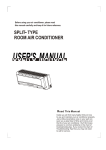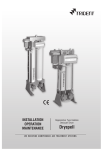Download WHMIS
Transcript
Workplace Hazardous Materials Information System Module 1 – Slide 3 – Student Notes – Page 2 WHMIS is a WORKPLACE legislation ONLY © 2008 TDG-WHMIS Compliance Centre Inc. This training material has been prepared in accordance with Federal Hazardous Products Act For ALL personnel who work with, are in proximity to or perform work involving the manufacture of a Controlled Product. WHMIS is a Federal Legislation for working safely with Controlled Products in the workplace, in Canada. ALL provinces have identical requirements for training „in proximity to‟ means, the area in which a worker‟s (including contract Workers and administrative personnel) health & safety could be at risk during the use, handling, storage or disposal of a Controlled Product, or emergencies such as „accidental release‟. © 2008 TDG-WHMIS Compliance Centre Inc. -- WHMIS -Workplace Hazardous Materials Information System • is a nationwide information system ensuring information regarding Controlled Products produced, sold in, imported or used in the workplace; is made available to the employer for: - - the safe use, handling, storage and disposal of Controlled Products through appropriate employee training, covering: - Material Safety Data Sheets - Controlled Products Supplier & Workplace labelling, and - Site-specific Worker Education reducing injuries, illness, death, medical costs & lost production © 2008 TDG-WHMIS Compliance Centre Inc. -- WHMIS -Workplace Hazardous Materials Information System • requires manufacturer‟s, suppliers and importers of Controlled Products to provide information in four very important areas: - Proper classification of the Controlled Product(s) - Affixing of the appropriate Supplier labels to properly packaged containers of Controlled Products - Development of a WHMIS Material Safety Data Sheet (MSDS) for the Controlled Product(s) - Providing the above information to their workplace customers © 2008 TDG-WHMIS Compliance Centre Inc. -- WHMIS -Workplace Hazardous Materials Information System • is not a legislation in itself (i.e. you cannot buy the WHMIS Regulations). WHMIS is an acronym, and as such includes the following Federal and Provincial/Territorial legislations: Federal Hazardous Products Act Covering the sale and importation of Controlled Products Canada Labour Code Covering Hazardous Materials (Controlled Products) usage in the workplace Provincial & Territorial Occupational Health & Safety Regulations Covering the implementation and enforcement (if necessary) of the WHMIS requirements © 2008 TDG-WHMIS Compliance Centre Inc. -- WHMIS -• the following four (4) groups are responsible for: Suppliers: - providing hazard information by labels and an MSDS on all Controlled Products/containers of Controlled Products Employers: - ensuring containers of Controlled Products, in the workplace, have WHMIS labels, identifiers & MSDS - keeping MSDSs readily available to employees - providing effective worker education Workers: - handling Controlled products in a safe manner - informing employer about damaged or missing labels Regulators: - developing & administering WHMIS legislation - providing employers with general information on WHMIS - ensuring compliance with WHMIS-related regulations (Federal & Provincial OH&S representatives) © 2008 TDG-WHMIS Compliance Centre Inc. -- WHMIS -• the employer is responsible to: Evaluate the workplace: - conduct an inventory of the Controlled Products produced/used in the workplace - conduct an inventory of partially exempted (i.e. consumer products) used and stored in the workplace - identify what is required for labels, identifiers and MSDS, and - identify employees who work with or are “in proximity to ”Controlled products in the workplace Assess the needs: - for worker education - for control measures including engineering controls, work and hygiene practices and Personal Protective Equipment (PPE) - for labels, identifiers (i.e. signage) and MSDSs, and - emergency procedures © 2008 TDG-WHMIS Compliance Centre Inc. -- WHMIS -• the employer is responsible (cont‟d): Develop Guidelines: - for the development, regular follow-up and review of ALL the components of WHMIS in the workplace, including: - the tracking, maintenance and availability for ALL MSDS documentation (including electronic retrieval) - the worker education program - the adequacy of existing labels, hazard identifiers and MSDS, and - as a recommendation, an annual review of the worker education program © 2008 TDG-WHMIS Compliance Centre Inc. -- WHMIS Worker Education -• this course training material has been prepared in accordance with Federal Hazardous Products Act and various Provincial and/or Territorial Health and Safety Chemical Hazard Regulations, for appropriate WORKER EDUCATION. An EMPLOYER SHALL ENSURE that a worker who works with, is “in proximity to”, or performs work involving the manufacture of a Controlled product receives instruction with respect to: (a) hazard information received from the supplier, and (b) any further hazard information of which the employer is aware, concerning the Controlled product © 2008 TDG-WHMIS Compliance Centre Inc. -- WHMIS Worker Education -• Worker Education (cont‟d): (c) the content required on a Supplier label and Workplace label and the purpose and significance of the information contained on them (d) the content required on a Material Safety Data Sheet and the purpose and significance of the information contained in it (e) procedures for the safe use, storage, handling or manufacture of that Controlled product (f) where applicable, the modes of identification of Controlled products in piping systems and vessels (g) procedures to be followed where fugitive emissions are present, and (h) procedures to be followed in case of an emergency involving a/the Controlled Product © 2008 TDG-WHMIS Compliance Centre Inc. -- WHMIS Worker Education -• Worker Education (cont‟d): An EMPLOYER SHALL ENSURE that the previously mentioned required instruction: (i) is developed and implemented for the employer‟s workplace (j) is developed and implemented in consultation with the joint workplace health and safety committee An EMPLOYER SHALL ENSURE, so far as is practical, that the required instruction results in the worker‟s being able to apply the information to protect the worker‟s health and safety A worker SHALL participate in the required instruction © 2008 TDG-WHMIS Compliance Centre Inc. “HOW WHMIS WORKS” SUPPLIER provides: Material Safety Data Sheets EMPLOYER provides: WHMIS Supplier Labels WHMIS Supplier or Workplace Labels (MSDS) Effective Visual Identification & Hazard Awareness Safe Use, Storage & Handling Informed & Trained Worker © 2008 TDG-WHMIS Compliance Centre Inc. WHMIS SiteSpecific Worker Education WHMIS CLASSIFICATION A Canadian Legislation for SAFETY in the WORKPLACE © 2008 TDG-WHMIS Compliance Centre Inc. WHMIS CLASSIFICATION CLASS A Compressed Gas CLASS B Flammable CLASS C Oxidizer CLASS D1 Poisonous (acute toxicity) CLASS D2 Poisonous (chronic toxicity) CLASS D3 Biohazardous Infectious CLASS E Corrosive CLASS F Dangerously Reactive © 2008 TDG-WHMIS Compliance Centre Inc. WHMIS CLASSIFICATION Through the Federal Hazardous Products Act and the Controlled Products Regulations, Controlled Products have been divided into six (6) Classes according to the type of danger presented or the material from which they are made. There are 6 classes of Controlled Products representing a type of danger presented or the material from which they are made. Two of the six classes (Classes B & D) have been further divided into “Divisions”: Divisions are represented as follows: EG: Class B, Division 3 or B3 [Combustible Liquids], or EG: Class D, Division 1A or D1A [Poisonous Substance – Acute Toxicity] © 2008 TDG-WHMIS Compliance Centre Inc. WHMIS CLASSIFICATION CLASS A Compressed Gas - Poses an explosion danger because the gas is held in a cylinder under pressure - container may explode if dropped or heated in a fire - handle with care, store away from sources of ignition Examples: Propane, Acetylene, Oxygen, Nitrogen, etc. © 2008 TDG-WHMIS Compliance Centre Inc. WHMIS CLASSIFICATION CLASS B - may burn at relatively low temperatures flammable materials catch fire at lower temperatures than combustible materials Flammable and Combustible - may burst into flame spontaneously in Materials air or release a flammable gas on contact with water - may cause fire when exposed to heat, sparks, flames or as a result of friction Examples: Methanol, Gasoline, Varsol, Diesel, Sulphur, Lithium, etc. See next for Divisions within Class B © 2008 TDG-WHMIS Compliance Centre Inc. WHMIS CLASSIFICATION CLASS B Flammable and Combustible Materials Has 6 divisions, as follows: Division 1 -- Flammable Gases (propane, butane) Division 2 -- Flammable Liquids (methanol, gasoline) Division 3 -- Combustible Liquids ( varsol, diesel) Division 4 -- Flammable Solids (sulfur) Division 5 -- Flammable Aerosols (engine starting fluid) Division 6 -- Reactive Flammable Materials (lithium) © 2008 TDG-WHMIS Compliance Centre Inc. WHMIS CLASSIFICATION CLASS C Oxidizing Material - causes or contributes to the combustion of another material by yielding oxygen or another oxidizing substance; whether or not the product itself is combustible - may cause fire, react violently or cause an explosion when in contact with combustible materials - it is an organic peroxide Examples: Ammonium Nitrate, Hydrogen Peroxide, etc. © 2008 TDG-WHMIS Compliance Centre Inc. WHMIS CLASSIFICATION CLASS D Poisonous and Infectious Materials have 3 divisions , as follows: Poisonous Material Division 1A - Toxic materials causing immediate, serious acute effects Division 1B - Toxic materials causing other acute effects Poisonous Material Division 2A - Very toxic materials causing chronic effects Division 2B - Toxic materials causing other chronic effects Infectious Material Division 3 - Biohazardous Infectious Materials © 2008 TDG-WHMIS Compliance Centre Inc. WHMIS CLASSIFICATION CLASS D1A & D1B Poisonous Substances ACUTE Toxicity - is a potentially fatal poisonous substance causing permanent damage if it is inhaled or swallowed or enters the body through skin contact - causes immediate and serious toxic effects (acute) Examples: Hydrogen Sulphide (H2S), Chlorine Gas etc. © 2008 TDG-WHMIS Compliance Centre Inc. WHMIS CLASSIFICATION CLASS D2A & D2B Poisonous Substances CHRONIC Toxicity Examples: - is a poisonous substance that is not immediately dangerous to health; however, it may cause death or permanent damage as a result of over exposure - causes other toxic effects (chronic) Asbestos Fibre, Mercury, Lead, etc. © 2008 TDG-WHMIS Compliance Centre Inc. WHMIS CLASSIFICATION CLASS D3 - may cause a disease resulting in illness or death Biohazardous Infectious Material Examples: Blood samples/body fluids (tuberculosis, hepatitis, HIV, etc.) © 2008 TDG-WHMIS Compliance Centre Inc. WHMIS CLASSIFICATION CLASS E Corrosive Material - causes severe eye & skin irritation on contact - causes severe tissue damage with prolonged contact - gases harmful if inhaled Examples: Battery Fluid Acid, Sulphuric Acid, many cleaning supplies © 2008 TDG-WHMIS Compliance Centre Inc. WHMIS CLASSIFICATION CLASS F Dangerously Reactive - is very unstable – undergoes vigorous polymerization (i.e.changes its chemical properties) - may react with water to form a toxic or flammable gas - may explode as a result of shock, friction or increase in temperature; or if heated when in a closed container Examples: Magnesium Powder, Picric Acid, Epoxy Resins © 2008 TDG-WHMIS Compliance Centre Inc. WHMIS CLASSIFICATION CLASS A Compressed Gas CLASS B Flammable CLASS C Oxidizer CLASS D1 Poisonous (acute toxicity) CLASS D2 Poisonous (chronic toxicity) CLASS D3 Biohazardous Infectious CLASS E Corrosive CLASS F Dangerously Reactive © 2008 TDG-WHMIS Compliance Centre Inc. -- MATERIAL SAFETY DATA SHEET -A Material Safety Data Sheet is like a USER Manual you would get when you purchase an appliance, electronic product, new car, etc.. (i.e. - thank you for buying our product, here is how you install, hook up and use our product. If you have any problems or need further information, please give us a call) © 2008 TDG-WHMIS Compliance Centre Inc. -- MATERIAL SAFETY DATA SHEET -The Supplier of the Controlled Product MUST provide an MSDS with or prior to the first shipment to the customer; or MUST provide an updated MSDS to the customer, when the Supplier has made a change to the MSDS This updated MSDS MUST be sent with the next shipment to the customer, or sooner if the change made effects safe handling procedures The customer MUST ensure that ALL MSDSs are current (i.e. NOT over three (3) years old from the date of preparation/revision) It is the customer’s responsibility to obtain a revised MSDS © 2008 TDG-WHMIS Compliance Centre Inc. -- MATERIAL SAFETY DATA SHEET -Materials Safety Data Sheets (MSDS) contain information that is more comprehensive than the information on WHMIS Supplier & Workplace labels The MSDS is the most comprehensive source of detailed information on a Controlled Product‟s properties, its major hazards and the basic measures to be taken to protect yourself against those hazards The MSDS MUST be available in English or French The requirements for the WHMIS MSDS development, include: (1) content, (2) format, (3) language © 2008 TDG-WHMIS Compliance Centre Inc. and (4) revision -- MATERIAL SAFETY DATA SHEET -The following shows a 9 Section MSDS you will see in the workplace 9 Section -- WHMIS MSDS Headings Section Heading 1. - Product Identifier or Product Information 2. - Ingredients Section or Regulated Components 3. - Physical Properties or Chemical Properties 4. - Fire and Explosion Hazard 5. - Reactivity Data 6. - Toxicological Properties or Health Hazard Information 7. - Precaution Measures or Preventive Measures 8. - First Aid Measures 9. - Preparation The next frame shows a 16 Section MSDS you will see in the workplace © 2008 TDG-WHMIS Compliance Centre Inc. Module 3 – Slide 5 – Student Notes – Page 19 -- MATERIAL SAFETY DATA SHEET -16 Section -- ANSI/ILO MSDS Headings Section Heading 1. - Product Identifier or Product Information 2. - Ingredients Section or Regulated Components ANSI 3. - Physical Properties or Chemical Properties American 4. - First Aid Measures National 5. - Fire and Explosion Hazard Standards 6. - Accidental Release Measures Institute 7. - Handling and Storage 8. - Exposure Controls, Personal Protection & Exposure limits 9. - Physical and Chemical Properties means, 10. - Stability and Reactivity ILO 11. - Toxicological Information or Health Hazard Information International 12. - Ecological Information Labor 13. - Disposal Considerations Organization 14. - Transport Information 15. - Regulatory Information 16. - Other Information © 2008 TDG-WHMIS Compliance Centre Inc. means, Module 3 – Slide 6 – Student Notes – Page 19 -- MATERIAL SAFETY DATA SHEET -The following 11 frames cover the Material Safety Data Sheet for the Controlled Product “VARSOL” © 2008 TDG-WHMIS Compliance Centre Inc. Module 3 – Slide 7 – Student Notes – Page 20 -- Sample MSDS - VARSOL -SECTION 1 -- PRODUCT IDENTIFIER/INFORMATION Product Identifier: VARSOL SOLVENT Application and Use: Solvent or Fuel Product Description: Aliphatic hydrocarbon Regulatory Classification: WHMIS Class B, Division 3 Manufacturer/Supplier: Imperial Oil – Products Division 111 St. Clair Avenue W. Toronto, ON M5W 1K3 (416) 968-4111 Emergency telephone number: (519) 339-2145 [24 hour service] What is the product? Who is the supplier? How do I contact them? © 2008 TDG-WHMIS Compliance Centre Inc. Module 3 – Slide 8 – Student Notes – Page 20 -- Sample MSDS - VARSOL -SECTION 2 -- INGREDIENTS SECTION The following component data is defined in accordance with the Federal Hazardous Products Act. NAME Stoddard Solvent %(v/v) CAS Number 100 8052-41-3 This Section informs you as to what the main ingredient(s) are and the percentages by volume of each ingredient(s). The “CAS Number”, shown above, represents a number assigned by the American Society of Chemists to a hazardous substance. © 2008 TDG-WHMIS Compliance Centre Inc. Module 3 – Slide 9 – Student Notes – Page 21 -- Sample MSDS - VARSOL -SECTION 3 -- PHYSICAL/Chemical PROPERTIES Physical State: Liquid Specific Gravity: 0.79 at 15.5oC Vapour Pressure: < 0.3kPa at 20oC Solubility in Water: <0.01% at 25oC Boiling Point: 158oC to 197oC Freezing/Melting Point: -58oC Viscosity: 1.14 cST at 25oC Vapour Density (air = 1): 4.8 Evaporation Rate: 0.1 approximately % Volatile: Odour: Mild Petroleum Odour Appearance: Clear, colourless liquid If the Supplier was to change the colour of the product (VARSOL) from a “clear, colourless liquid” to a “BLUE coloured liquid”; then, the Supplier would have to send an updated MSDS to the client with the next shipment If you ONLY „work with‟ the Controlled Product; then, you might ONLY want/need to know if it is a solid, liquid or gas; what does it look like and what does it smell like (odour). © 2008 TDG-WHMIS Compliance Centre Inc. Module 3 – Slide 10 – Student Notes – Page 21 -- Sample MSDS - VARSOL -SECTION 4 -- FIRE and EXPLOSION HAZARD Flash Point & Method: 43oC TCC [closed-cup test in laboratory] Auto-Ignition Temperature: 229oC [approximately] Flammable Limits (lower & upper): 1 to 13.3% by volume [approximately] GENERAL HAZARDS: Combustible liquid; may form combustible mixtures at or above the flash point. Toxic gases will form on combustion. © 2008 TDG-WHMIS Compliance Centre Inc. -- Sample MSDS - VARSOL -SECTION 4 -- FIRE and EXPLOSION HAZARD (continued) HAZARDOUS COMBUSTION PRODUCTS: Fumes, smoke & carbon monoxide („Carbon Monoxide‟ is a highly toxic gas that prevents oxygen from being carried to blood tissue; thus, resulting in breathing difficulties, headaches, dizziness, nausea and possible death.) FIRE FIGHTING: Cool exposed surfaces. Wear respiratory and eye protection. A Self-contained Breathing Apparatus (SCBA) is recommended for indoor fires and significant outdoor fires. Either the liquid or vapour may settle in low areas or travel some distance along the ground or surface to ignition sources where they may ignite or explode. © 2008 TDG-WHMIS Compliance Centre Inc. Module 3 – Slide 12 – Student Notes – Page 22 -- Sample MSDS - VARSOL -SECTION 5 -- REACTIVITY DATA This product is stable and hazardous polymerization (i.e. the properties of the chemical change) will not occur. INCOMPATIBLE MATERIALS & CONDITIONS TO AVOID: Strong OXIDIZING agents („Oxidizing Agents‟ are substances or materials which cause or contribute to combustion of another material by yielding oxygen or an oxidizing substance; whether or not the substance itself is combustible) HAZARDOUS DECOMPOSITION: not applicable This section tells you what other substances this product will react with. Many times you will see this information used again in the Preventive Measures/ Precautionary Measures section to identify appropriate storage considerations © 2008 TDG-WHMIS Compliance Centre Inc. Module 3 – Slide 13 – Student Notes – Page 23 -- Sample MSDS - VARSOL -SECTION 6 -- HEALTH HAZARD INFORMATION EFFECTS ON YOUR HEALTH: (how this product can harm you) INHALATION: High vapour concentrations (greater than 100 parts per million [ppm]) are irritating to the eyes, respiratory tract, may cause headaches, dizziness, drowsiness and other central nervous system [CNS] effects; including death EYE CONTACT: Slightly irritating, will not injure the eye tissue SKIN CONTACT: Frequent and prolonged contact may irritate the skin and cause a skin rash (dermatitis) INGESTION: Small amount aspirated (ingested into the lungs) into the respiratory system during ingestion or from vomiting may cause mild to severe pulmonary (pertaining to the lungs) injury and possible death. © 2008 TDG-WHMIS Compliance Centre Inc. Module 3 – Slide 14 – Student Notes – Page 23 -- Sample MSDS - VARSOL -SECTION 6 -- HEALTH HAZARD INFORMATION There are four (4) routes of entry, of a Controlled product, into the body: INHALATION INGESTION EYES © 2008 TDG-WHMIS Compliance Centre Inc. SKIN Module 3 – Slide 15 – Student Notes – Page 24 -- Sample MSDS - VARSOL -SECTION 7 -- PREVENTIVE/PRECAUTIONARY MEASURES PERSONAL PROTECTION: The selection of personal protective equipment [PPE] varies depending upon conditions of use. Where prolonged and/or repeated skin and eye contact is likely to occur, wear safety glasses with side shields (or chemical splash goggles), long sleeves (coveralls) and chemical resistant gloves. Where concentrations in air may exceed occupational exposure limits given in Section 6 (of this MSDS) and where engineering, work practices or other means of exposure reduction are not adequate, approved respirators may be necessary to prevent overexposure by inhalation. © 2008 TDG-WHMIS Compliance Centre Inc. Module 3 – Slide 16 – Student Notes – Page 24 -- Sample MSDS - VARSOL -SECTION 7 -- PREVENTIVE/PRECAUTIONARY MEASURES (cont‟d) HANDLING and STORAGE: Keep containers closed. Handle and open containers with care. Store in cool well ventilated area away from incompatible materials. („Incompatible Materials‟ are materials that cause dangerous reactions and the release of energy from direct contact with another material or substance.) (Refer to REACTIVITY DATA section to be certain.) DO NOT handle or store near open flame, heat or other sources of ignition. Protect material from direct sunlight. Materials may accumulate static charges which will cause electrical spark (ignition source) – use proper grounding procedures. DO NOT pressurize, cut, heat or weld containers. Empty product containers may contain product residue – DO NOT reuse empty containers without commercial cleaning (purging) or reconditioning. © 2008 TDG-WHMIS Compliance Centre Inc. -- Sample MSDS - VARSOL -SECTION 7 -- PREVENTIVE/PRECAUTIONARY MEASURES (cont‟d) ENGINEERING CONTROLS: The use of local exhaust ventilation is recommended to control emissions near the source. Provide mechanical ventilation of confined spaces. SPILL CONTROL and DISPOSAL: Consult an expert on the disposal of recovered material. Ensure disposal in compliance with government requirements and ensure conformity to local disposal regulations. LAND and WATER SPILL: Eliminate sources of ignition. Keep public away. Prevent additional discharge of product. Conduct product containment and cleanup as per specified procedures or seek professional assistance. © 2008 TDG-WHMIS Compliance Centre Inc. -- Sample MSDS - VARSOL -SECTION 8 -- FIRST AID MEASURES INHALATION: In emergency situations, use proper respiratory protection to immediately remove the affected victim from exposure. Administer artificial respiration if breathing has stopped. Keep at rest. Call for prompt medical attention. EYE CONTACT: Flush eyes with large amounts of water until irritation subsides. If irritation persists, get medical attention. SKIN CONTACT: Immediately flush with large amounts of water. Use soap if available. Remove contaminated clothing, including shoes, after flushing has begun. INGESTION: If swallowed, DO NOT INDUCE vomiting. Keep at rest and get prompt medical attention.. © 2008 TDG-WHMIS Compliance Centre Inc. -- Sample MSDS - VARSOL -SECTION 9 -- PREPARATION DATE PREPARED: January 3, 2004 DATE REVISED: December 3, 2004 PREPARED BY: Lubricants and Specialties Imperial Oil Products Division 111 St. Clair Avenue W. Toronto, ON M5W 1K3 1-800-268-3183 This MSDS is no longer valid as it is 3 years older than the latest revision date. © 2008 TDG-WHMIS Compliance Centre Inc. -- MATERIAL SAFETY DATA SHEET -- REMEMBER Material Safety Data Sheets MUST BE UPDATED, when: - they are MORE THAN 3 YEARS OLD, or - when the Supplier has MADE A CHANGE to the MSDS - MUST be available to workers, on ALL shifts - MUST be in customer‟s choice of English or French © 2008 TDG-WHMIS Compliance Centre Inc. WHMIS LABELS Labelling (Supplier, Workplace and Pipes & Piping Systems) is required under the Federal Hazardous Products Act, and subsequently various Provincial/Territorial Health & Safety Chemical Hazards Regulations – FOR THE SAFE USE, STORAGE, HANDLING AND DISPOSAL of Controlled Products in the workplace Labelling will give you an indication of the hazard(s) associated with the Controlled Product you are using. The hazard symbol on a WHMIS Supplier or Workplace label gives a quick reference as to the hazard(s) of the Controlled Product Class A Class B Class C Class D1 Class D2 Class D3 Class E Class F Compressed Gas Flammable Oxidizer Poisonous/ Toxic (Acute) Poisonous/ Toxic (Chronic) Biohazardous Infectious Corrosive Dangerously Reactive © 2008 TDG-WHMIS Compliance Centre Inc. WHMIS SUPPLIER LABELS ENGLISH & FRENCH PRODUCT IDENTIFIER (both languages required on label) (same as on MSDS) RISK PHRASES (alert handler to hazards) WHMIS HAZARD SYMBOLS (Corrosive & Acute Toxicity) PRECAUTION MEASURES (safe use, handling information) FIRST AID MEASURES REFERENCE TO MSDS (what to do in case of a medical emergency) (most comprehensive information about the product) SUPPLIER IDENTIFICATION (ONLY the name is required) ALL Information contained within a Cross-Hatched Border Hazard Symbols normally show the MOST serious symbol first, followed by the next next hazard, etc. (i.e. – left to right or top to bottom – above: Corrosive is the main hazard; then, Poisonous [acute toxicity]) © 2008 TDG-WHMIS Compliance Centre Inc. WHMIS WORKPLACE LABELS Note: The workplace label ONLY requires the Product Identifier, Safe Use & Handling statement and Reference to the Material Safety Data Sheet PRODUCT IDENTIFIER (same as on Supplier label and Material Safety Data Sheet) There is NO requirement for French or borders on a WHMIS Workplace label Same name as the Supplier Label and MSDS (or the name the employees are MOST accustom to) PRECAUTION MEASURES/ PREVENTIVE MEASURES (safe use, handling information) Examples: „Avoid contact with skin & eyes‟ „Goggles and Gloves required‟ The MOST comprehensive information about the hazards of the product and how to protect yourself Reference to the MATERIAL SAFETY DATA SHEET See sample workplace containers on next slide © 2008 TDG-WHMIS Compliance Centre Inc. WHMIS Sample Workplace Containers © 2008 TDG-WHMIS Compliance Centre Inc. WHMIS Sample „PACE‟ WORKPLACE LABEL PRODUCT IDENTIFIER (same as on Supplier label and Material Safety Data Sheet) Black out the Hazard Symbol(s) which are not applicable to the appropriate hazard WHMIS Hazard Symbols Black out the Hazard Symbol(s) which are not applicable to the appropriate PPE Personal Protective Equipment Pictograms Safe Use/Handling Statement Reference to the MSDS See sample workplace labels on next slide © 2008 TDG-WHMIS Compliance Centre Inc. WHMIS Sample Workplace Labels © 2008 TDG-WHMIS Compliance Centre Inc. WHMIS Sample „HMIS‟ Workplace LABEL Same name as the Supplier Label and MSDS (or the name the employees are MOST accustom to) PRODUCT IDENTIFIER (same as on Supplier label and Material Safety Data Sheet) Numeric Hazard Code: 0 – MINIMAL 1 – SLIGHT 2 – MODERATE 3 – SERIOUS 4 – EXTREME PRECAUTION MEASURES PERSONAL PROTECTIVE EQUIPMENT (alphabetic designation) Alphabetic Person Protective Equipment designation (requiring an employee card showing the different PPE required for the different Alphabetic designations – see next) Reference to the MATERIAL SAFETY DATA SHEET © 2008 TDG-WHMIS Compliance Centre Inc. Sample „HMIS‟ Employee PPE Card NOTE: If the employee does not have this card, it would be extremely difficult to determine the proper PPE to wear when handling a Controlled Product at the work site. © 2008 TDG-WHMIS Compliance Centre Inc. WHMIS Pipemarking LABELS Pipes or piping systems, can be identified by labels, stencils, colour coding, placards or any mode of identification; so long as everyone understands the hazard identification system. © 2008 TDG-WHMIS Compliance Centre Inc. WHMIS Information Flow MSDS Supplier Label Product ID Product ID Manuf./Supplier Information Manuf./Supplier Information Hazardous Ingredients Physical Data Fire & Explosion Data You are going from 4 to 8 pages of MSDS information to a Supplier label that, on average, is 8” x 10” [english portion of label is approximately 8” x 5”]; where instead of a page of information, you now have a paragraph of information Workplace Label Product ID Then, you are required to put a ‘safe use handling’ statement on a workplace label [that on average is 3” x 6”]. Most likely this will be a phrase or a couple of words. Reactivity Data Protective Measures Protective Measures First Aid Measures First Aid Measures Protective Measures Preparation Data Risk Phrases WHMIS Hazard Symbols Hazard symbols not required, but can be used English & French Cross-hatched Border Refer to MSDS Refer to MSDS See WHMIS Labelling Requirements SUMMARY Chart on next 2 slides © 2008 TDG-WHMIS Compliance Centre Inc. WHMIS Labelling Requirements -- SUMMARY Requirements 1. Product ID Supplier Label: (>100mL) Supplier Label: (<100mL) Laboratory Label: Supply House (<10kg) Laboratory Label: Sample (<10kg) Workplace Label or Placard 2. Hazardous Ingredients 3. Hazard Symbols 4. Risk Phrase(s) 5. Precautionary Measures 6. Safe Handling 7. First Aid Measures continued on next slide © 2008 TDG-WHMIS Compliance Centre Inc. WHMIS Labelling Requirements -- SUMMARY Requirements Supplier Label: (>100mL) Supplier Label: (<100mL) 8. Supplier Information 9. Reference to MSDS Laboratory Label: Supply House (<10kg) Laboratory Label: Sample (<10kg) Workplace Label or Placard 10. Emergency Telephone Number 11. Cross-hatched Border 12. English 13. French 14. Other Language © 2008 TDG-WHMIS Compliance Centre Inc. WHMIS TOTAL EXEMPTIONS The following are products that are excluded from ALL aspects of the WHMIS legislation: Wood and products made from wood (lumber, plywood, particle board, etc.) Tobacco and products made from tobacco (cigarettes, cigars, etc.) Dangerous goods while in transport (under the TDG Clear Language Regulations) Manufactures articles (garbage bags, etc.) Hazardous wastes (controlled products that are intended for disposal or that are sold for recycling or recovery) © 2008 TDG-WHMIS Compliance Centre Inc. WHMIS PARTIAL EXEMPTIONS The following are exempt from the criteria for WHMIS Material Safety Data Sheets and Supplier Labels (i.e. supplier aspects): an explosive within the meaning of the Explosives Act (Canada) a cosmetic, device, drug or food within the meaning of the Food and Drug Act (Canada) a controlled product (pesticides & herbicides) within the meaning of the Pest Control Products Act (Canada) A prescribed substance (radioactive materials) within the meaning of the Atomic Energy Control Act (Canada) A product, material or substance packed as a Consumer Product and in quantities normally used by the consuming public (examples: paints, bleaches and cleansers containing chlorine) © 2008 TDG-WHMIS Compliance Centre Inc. WHMIS Employee Responsibilities In summary, a worker shall: 1. understand the content, purpose and significance of the MSDS information 2. understand the content, purpose and significance of the information contained on a Supplier and Workplace label 3. understand safe use, handling, storage and disposal procedures for the controlled products they are working with 4. understand the specific information requirements for controlled products in pipes, vessels and tank car/truck 5. understand emergency procedures related to the controlled products 6 if work conditions or hazard information changes, receive updated training 7. inform the employer of circumstances where the employee does not have adequate information to ensure employee safety, and 8. work with the employer to develop, implement and review training programs © 2008 TDG-WHMIS Compliance Centre Inc. Consumer Products Labelling It is important to know the Consumer Products you are using, handling, storing and/or disposing of. Consumer Products (i.e. products that are packaged and distributed in a quantity and concentration intended or suitable for sale through retail agencies for consumption by individuals for the purposes of personal care or household use) are exempt from the WHMIS Supplier Label and MSDS requirements; however, NOT from the employer‟s responsibilities regarding worker education and workplace labelling. The employer is required to ensure employees are familiar with all aspects of safe use and handling of Consumer Products (i.e. WD40) that are brought into the workplace. Should a Consumer Product label (panel) become marred or illegible; then, a proper WHMIS Workplace label MUST be applied. © 2008 TDG-WHMIS Compliance Centre Inc. Consumer Products Labelling Consumer Products that are classified as „Regulated Products‟, are required to disclose certain mandatory information on a panel (label), as per the „Consumer Chemicals and Containers Regulations‟ (Canada); as follows: - hazard symbols (see next slide) - signal words (DANGER, WARNING, ATTENTION, ETC), and - primary hazard statements The following required information, shall be disclosed anywhere (except the bottom) on a/the panel (label) of the „Regulated Product: - additional hazard statements, and - first aid statements © 2008 TDG-WHMIS Compliance Centre Inc. Consumer Products Labelling CONSUMER PRODUCT HAZARD SYMBOLS DANGER WARNING for COMPRESSED CAUTION GASES for FLAMMABLE Substances for POISONOUS Substances for CORROSIVE Substances © 2008 TDG-WHMIS Compliance Centre Inc. Consumer Products Labelling Workers MUST be educated on the safe use, handling, storing and disposal of the Controlled Products in their workplace Example: WD-40 - is a Consumer Product If you read a WD-40 aerosol can, you will read the following: “Keep away from flame or sparks. Contents under pressure. DO NOT place in hot water or near radiators, stoves or other sources of heat. DO NOT puncture or incinerate or store at temperatures above 50oC.” First Aid Treatment: - Contains mineral spirits. If swallowed DO NOT induce vomiting. Call a physician immediately. RISK Statements: - Direct inhalation of spray may be harmful. - Container may explode if heated. - EXTREMELY flammable. © 2008 TDG-WHMIS Compliance Centre Inc. Consumer Products Labelling CONSUMER PRODUCT HAZARD SYMBOLS for WD-40 DANGER POISONOUS DANGER FLAMMABLE © 2008 TDG-WHMIS Compliance Centre Inc. CAUTION EXPLOSIVE Personal Protective Equipment Pictograms GOGGLES GLOVES BOOTS will protect your eyes from chemical splashes and flying objects. BODY SUIT will protect your hands from coming in contact with chemicals sharp objects DUST MASK will protect your feet from chemical spills, falling objects and sharp projections CARTRIDGE RESPIRATOR APRON will help protect you and your clothing from chemical splashes and spills FACE SHIELD will protect the entire face area from chemical splashes and flying objects © 2008 TDG-WHMIS Compliance Centre Inc. SELFCONTAINED BREATHING APPARATUS will provide full body protection where required will protect you from inhaling airborne dust particles, fibres or mechanically generated particles will protect you from airborne contaminants or toxic gases will protect you when you require oxygen, depending on the hazard assessment Thank You for taking this WHMIS training program on final completion, of your test, with a score of 80% or greater you will receive your WHMIS Student Training Certificate © 2008 TDG-WHMIS Compliance Centre Inc.





































































